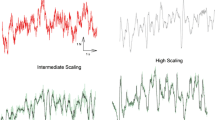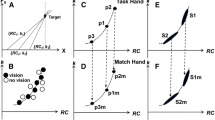Summary
This study was undertaken in order to determine the time course of the process by which information derived from a visual target is used to accurately set the amplitude of a simple motor response. We refer to this process as response specification. Separate auditory and visual cues were given to the subjects in order to independently control the moment of response initiation and the time available for processing amplitude information from the target. Six subjects initiated impulses of isometric force in synchrony with the last of predictable series of regular tones. Response amplitudes were to match one of three visual target steps occurring at random times between 0 and 400 ms before the response-synchronizing tone. Using these separate auditory and visual cues, we were able to systematically vary the time interval between target presentation and response onset, termed here Stimulus-Response or S-R interval. Target steps were presented in blocks of either predictable (simple condition) or unpredictable (choice condition) amplitudes. The peak forces and the peaks of their time derivatives were analyzed to determine how subjects achieved accuracy under the different conditions and at different S-R intervals. The trajectories of responses produced in the simple condition were independent of the S-R interval. In contrast, when targets were presented in unpredictable order, the distribution of the peak forces of the subjects' responses depended on the S-R interval. At short S-R intervals (<125 ms), subjects made responses whose peak forces were distributed around the center of the range of target steps. These responses formed a unimodal, but broad distribution which was independent of actual target amplitude. With increasing S-R interval (>125 ms), the distributions of peak forces gradually shifted toward the correct target amplitudes, with the means reaching the appropriate amplitudes at S-R intervals of 250–400 ms. At S-R intervals comparable to a reaction time, the range of peak forces was constricted to a similar extent as previously observed in a reaction time task (Hening et al. 1988). We found that the gradual improvement of accuracy was not achieved through changes in trajectory control: at all S-R intervals, subjects utilized a pulse-height control policy (Gordon and Ghez 1987a). Different peak forces were achieved by varying the rate of rise of force, while force rise time was held relatively invariant. We did find, however, that within the constraints imposed by rise time regulation, compensatory adjustments to the force trajectories (Gordon and Ghez 1987b) were greatest during the period of specification. We conclude that (1) subjects can initiate their responses independent of the degree of specification achieved and that the normal process of specification of amplitude begins earlier and continues longer than the latency of responses in a reaction time task; (2) before target presentation, subjects prepare a default response whose amplitude is biased by prior experience with the targets presented in the task. We hypothesize that the central mechanisms that specify response amplitude do so by a progressive adjustment of the default parameters.
Similar content being viewed by others
References
Bahill AT, Clark MR, Stark L (1975) The main sequence: a tool for studying eye movements. Math Biosci 24: 191–204
Chambers JM, Cleveland WS, Kleiner B, Tukey PA (1983) Graphical methods for data analysis. Duxbury Press, Boston
Cleveland WS (1979) Robust locally weighted regression and smoothing scatterplots. J Am Stat Assoc 74: 829–836
Cordo PF (1987) Mechanisms controlling accurate changes in elbow torque in humans. J Neurosci 7: 432–442
Donders FC (1869) On the speed of mental processes. Translated and reprinted in Acta Psychol 30:412–431
Favilla M, Hening W, Ghez C (1985) Human tracking performance: parallel specification of amplitude and direction. Neuroscience Abstr 11: 72
Favilla M, Hening W, Ghez C (1987) Independent specification of response features in a reaction time paradigm. Neuroscience Abstr 13: 13
Favilla M, Hening W, Gordon J, Ghez C (1986) Preparatory set: independent specification of direction and size in the preparation of responses to a range of targets. Neuroscience Abstr 12: 972
Fitts PM (1954) The information capacity of the human motor system in controlling the amplitude of movement. J Exp Psychol 47: 381–391
Ghez C (1979) Contributions of central programs to rapid limb movement in the cat. In: Asanuma H, Wilson V (eds) Integration in the nervous system. Igaku-Shoin, Tokyo, pp 305–319
Ghez C, Gordon J (1987) Trajectory control in targeted force impulses. I. Roles of opposing muscles. Exp Brain Res 67: 225–240
Ghez C, Hening W, Favilla M (1988) Parallel specification of response amplitude in human tracking performance. Behav Brain Res (in press)
Ghez C, Vicario D, Martin JH, Yumiya H (1983) Sensorimotor processing of targeted movements in motor cortex. In: Desmedt JE (ed) Motor control mechanisms in health and disease. Raven Press, New York, pp 61–92
Gordon J, Ghez C (1984) EMG patterns in antagonist muscles during isometric contraction in man: relations to response dynamics. Exp Brain Res 55: 167–171
Gordon J, Ghez C (1985) Mechanisms contributing to accuracy in aimed force impulses: rise time regulation and corrective adjustments. Soc Neurosci Abstr 11: 75
Gordon J, Ghez C (1987a) Trajectory control in targeted force impulses. II. Pulse height control. Exp Brain Res 67: 241–251
Gordon J, Ghez C (1987b) Trajectory control in targeted force impulses. III. Compensatory adjustments for initial errors. Exp Brain Res 67: 252–269
Gottsdanker R, Shragg GP (1985) Verification of Donders' subtraction method. J Exp Psychol (Hum Percept Perform) 11: 765–776
Hening W, Ghez C (1984) Processes underlying the initiation and specification of responses in a human tracking task. Neuroscience Abstr 10: 801
Hening W, Vicario D, Ghez C (1988) Trajectory control in targeted force impulses. IV. Influences of choice, prior experience and urgency. Exp Brain Res 71: 103–115
Higgins JR, Angel RW (1970) Correction of tracking errors without sensory feedback. J Exp Psychol 84: 412–416
Kantowitz BH (1985) Channels and stages in human information processing: a limited analysis of theory and methodology. J Math Psychol 29: 135–174
Keele SW, Posner MI (1968) Processing of visual feedback in rapid movements. J Exp Psychol 77: 155–158
Miller J (1982) Discrete versus continuous stage models of human information processing: in search of partial output. J Exp Psychol (Hum Percept Perform) 8: 273–296
Pachella RG (1974) The interpretation of reaction time in information processing research. In: Kantowitz B (ed) Human information processing. Erlbaum, Hillside, New Jersey, pp 41–82
Pew RW (1969) The speed-accuracy operating characteristic. Acta Psychol 30: 16–26
Poulton EC (1975) Range effects in experiments on people. Am J Psychol 88: 3–32
Poulton EC (1981) Human manual control. In: Brooks VB (ed) Handbook of physiology, Sec 1. The nervous system, Vol 2. Motor control. American Physiological Society, Bethesda, pp 1337–1389
Sanders AF (1980) Stage analysis of reaction processes. In: Stelmach GE, Requin J (eds) Tutorials in motor behavior. Amsterdam, North Holland, pp 331–354
Schouten JF, Bekker JAM (1967) Reaction time and accuracy. Acta Psychol 27: 143–153
Sternberg S (1969) The discovery of processing stages. Extensions of Donders' method. Acta Psychol 30: 276–315
Swensson RG (1972) The elusive tradeoff: speed versus accuracy in visual discrimination tasks. Percept Psychophys 12: 16–32
Taylor DA (1976) Stage analysis of reaction time. Psychol Bull 83: 161–191
Welford AT (1952) The “psychological refractory period” and the timing of high-speed performance — a review and a theory. Br J Psychol 43: 2–19
Welford AT (1967) Single-channel operation in the brain. Acta Psychol 27: 5–22
Welford AT (1980) Reaction times. Academic Press, New York
Wickelgren WA (1977) Speed-accuracy tradeoff and information processing dynamics. Acta Psychol 41: 67–85
Author information
Authors and Affiliations
Rights and permissions
About this article
Cite this article
Hening, W., Favilla, M. & Ghez, C. Trajectory control in targeted force impulses. Exp Brain Res 71, 116–128 (1988). https://doi.org/10.1007/BF00247527
Received:
Accepted:
Issue Date:
DOI: https://doi.org/10.1007/BF00247527




